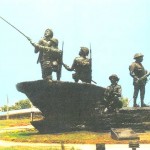
Engulfed in the early morning fog, the Palam Airport New Delhi, on October 27, 1947, was witnessing a history in the making. Few military trucks were ferrying men and stores to the Dakotas DC 47, belonging to the 12 Squadron Indian Air Force parked on the tarmac. The previous night, Lieutenant Colonel Dewan Ranjit Rai, Commanding Officer, 1st Battalion the Sikh Regiment was ordered to undertake an air-transported operation to deal with an uncertain and precarious operational situation. The destination was unsecured; weather was threatening to play truant; and the chances of success hanged literally by a slender thread. With prayer on their lips and courage in their hearts the first wave of aircrafts took off at 0500 hours from Palam for Srinagar in the Kashmir Valley. At 0830 hours, the first aircraft touched down the rough and dusty Srinagar airstrip. The successive waves of Dakotas (many of them requisitioned from the civil airlines) had delivered the battalion group of 1 Sikh comprising the battalion’s tactical headquarter and two companies to stop the marauding hordes of Pakistan Army led lshkars that were pouring across the border into Jammu and Kashmir. Indian response in the form of first military operation of Independent India to the Pakistan’s Operation Gulmarg had commenced.
Except for a small detail of State Forces there were no forces between the lashkars (engaged in an orgy of loot, rape and murder) in Baramulla and the capital city of Srinagar. Realising the grave situation, Lieutenant Colonel Dewan Ranjit Rai pushed one company ahead to join the detachment of the State Forces, located five kilometers east of Baramulla. On October 28, Lieutenant Colonel Raireached Baramulla with his battalion and was overseeing operations when he attained martyrdom in action. Lieutenant Colonel Rai was awarded Maha Vir Chakra posthumously, the first recipient of this gallantry award. Retrieving the precarious situation by driving out the lashkars in a series of battles the infantry repulsed the enemy back on the axis Srinagar – Baramulla – Kupwara – Tangdhar. Rest is history.
1947-48 war with Pakistan, when the Indian Army was still recovering from the trauma of partition is the finest example of what the army, particularly the infantry can do within it its meager means no matter how daunting are the challenges. Befittingly, October 27 was marked as Infantry Day.
Dubbed as the Queen of Battles by Sir William Napier (1785-1860), the Indian infantry regiments have scripted saga of bravery in all wars and theatres.
Over the years, the technology has transformed the battlefields. The night has become day. The infra-red can unravel the camouflage. The weapons are accurate, lethal and capable of delivering a variety of munitions. There are chemical, biological, radiological and nuclear threats poised against the infantry. Tactical battle area has enlarged in terms of ranges and encompassed the third dimension for surveillance, target acquisition and mounting an attack.
Infantry undertakes operations in a variety of terrain and operational conditions. Such peculiarities now demand terrain and role specific weapons, equipment, mobility and fire support. Survivability of infantry in today’s battlefield is a challenge, which needs to be ensured by better protective gear, pre-fabricated modular field fortifications and capability to preempt the incoming threats.
While the big ticket purchases for the sister Services and other arms in the army are relatively fast, the requirements of the infantry are not pursued with urgency and dispatch it deserves. It took three decades to provide an assault rifle to the infantry.
In today’s context the infantry needs to have situational awareness and a variety of weapons to engage the emerging threats. The ongoing Russia-Ukraine war holds many lessons for the infantry. The ground holding capability cannot be sacrificed for mobility sake. Russia, in a desperate measure is now adopting a defensive posture to stop the onslaught of the Ukrainian forces. The training of infantry should not be tinkered with. It should be conducted thoroughly. It is a pitiable sight to see hastily mobilized and cursorily trained Russian troops getting killed, deserting the frontlines, refusing to obey the command or simply surrendering. Modern weaponry brings down intense fire on the defences; infantry needs to have better protection from the area weapons which have turned so accurate and devastating of late due to technology.
Infantry’s comrade in arms – the infantry regiments, the Special Forces, the mechanized infantry, the scouts and the Rashtriya Rifles on this special day deserve to be felicitated for the wonderful job these forces have been doing on the line of control, the actual ground position line, the line of actual control, in the counter insurgency and terrorists operations on the borders and in the hinterland. Long live the Queen of Battles.




